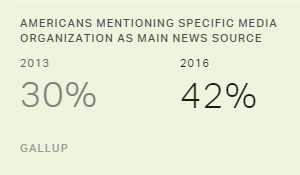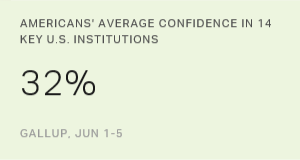Story Highlights
- Those mentioning a type of media have fallen from 58% to 48% since 2013
- Specific mentions of media organizations have risen from 30% to 42%
- Those younger than 35 turning to social media sites for news
WASHINGTON, D.C. -- As the ways people consume news grow more complex, Americans are becoming less likely to view their news sources in terms of how they get news -- radio, television, print or internet -- and more in terms of who specifically provides it. Forty-eight percent of U.S. adults still identify a type of media as their main news source, but that is down from 58% just three years ago. Meanwhile, the percentage naming a specific media organization is up from 30% to 42%.
| 2013 | 2016 | ||||||||||||||||||||||||||||||||||||||||||||||||||||||||||||||||||||||||||||||||||||||||||||||||||
|---|---|---|---|---|---|---|---|---|---|---|---|---|---|---|---|---|---|---|---|---|---|---|---|---|---|---|---|---|---|---|---|---|---|---|---|---|---|---|---|---|---|---|---|---|---|---|---|---|---|---|---|---|---|---|---|---|---|---|---|---|---|---|---|---|---|---|---|---|---|---|---|---|---|---|---|---|---|---|---|---|---|---|---|---|---|---|---|---|---|---|---|---|---|---|---|---|---|---|---|
| % | % | ||||||||||||||||||||||||||||||||||||||||||||||||||||||||||||||||||||||||||||||||||||||||||||||||||
| Type of media (combined) | 58% | 48% | |||||||||||||||||||||||||||||||||||||||||||||||||||||||||||||||||||||||||||||||||||||||||||||||||
| Television news | 26 | 22 | |||||||||||||||||||||||||||||||||||||||||||||||||||||||||||||||||||||||||||||||||||||||||||||||||
| Internet/Computer/Online | 18 | 16 | |||||||||||||||||||||||||||||||||||||||||||||||||||||||||||||||||||||||||||||||||||||||||||||||||
| Newspaper | 6 | 5 | |||||||||||||||||||||||||||||||||||||||||||||||||||||||||||||||||||||||||||||||||||||||||||||||||
| Local television news | 4 | 2 | |||||||||||||||||||||||||||||||||||||||||||||||||||||||||||||||||||||||||||||||||||||||||||||||||
| Radio | 4 | 2 | |||||||||||||||||||||||||||||||||||||||||||||||||||||||||||||||||||||||||||||||||||||||||||||||||
| Media organization (combined) | 30% | 42% | |||||||||||||||||||||||||||||||||||||||||||||||||||||||||||||||||||||||||||||||||||||||||||||||||
| Fox News | 8 | 9 | |||||||||||||||||||||||||||||||||||||||||||||||||||||||||||||||||||||||||||||||||||||||||||||||||
| CNN | 7 | 8 | |||||||||||||||||||||||||||||||||||||||||||||||||||||||||||||||||||||||||||||||||||||||||||||||||
| Facebook/Twitter/Social media | 2 | 6 | |||||||||||||||||||||||||||||||||||||||||||||||||||||||||||||||||||||||||||||||||||||||||||||||||
| Specific internet site | 1 | 4 | |||||||||||||||||||||||||||||||||||||||||||||||||||||||||||||||||||||||||||||||||||||||||||||||||
| NPR | 1 | 2 | |||||||||||||||||||||||||||||||||||||||||||||||||||||||||||||||||||||||||||||||||||||||||||||||||
| MSNBC | 1 | 2 | |||||||||||||||||||||||||||||||||||||||||||||||||||||||||||||||||||||||||||||||||||||||||||||||||
| Responses include all answers totaling at least 2% in 2016 poll | |||||||||||||||||||||||||||||||||||||||||||||||||||||||||||||||||||||||||||||||||||||||||||||||||||
| Gallup polls, June 20-24, 2013, and June 14-23, 2016 | |||||||||||||||||||||||||||||||||||||||||||||||||||||||||||||||||||||||||||||||||||||||||||||||||||
"Television news" and "internet/computer/online" are still the most popular answers when Americans are asked to name their "main source of news about current events in the U.S. and around the world." But they are slightly less likely to name each one than they were in 2013. Meanwhile, numerous individual media organizations such as Fox News, NPR and various internet sites saw small gains that were not statistically significant on an individual basis but showed a major increase when combined into total mentions of specific media organizations.
The poll was not designed to give a comprehensive listing of the most popular news organizations or the most popular means of receiving news. Instead, it provides insight into how Americans think about news sources in general.
The shift in thinking on the subject is partly powered by Americans' increasing ability to gather news from a single organization on multiple platforms. Every major television and print news organization has a presence on the internet, and internet sites produce videos that, through streaming devices, can be viewed on a television screen.
Women, who three years ago were significantly more likely to mention a method of receiving the news (type of media) than a specific media organization, are now about as likely as men to list a media organization. Democrats and those who lean Democratic have moved closer to Republicans and their leaners. The shift by age is even more striking.
| Media organizations, 2013 | Media organizations, 2016 | ||||||||||||||||||||||||||||||||||||||||||||||||||||||||||||||||||||||||||||||||||||||||||||||||||
|---|---|---|---|---|---|---|---|---|---|---|---|---|---|---|---|---|---|---|---|---|---|---|---|---|---|---|---|---|---|---|---|---|---|---|---|---|---|---|---|---|---|---|---|---|---|---|---|---|---|---|---|---|---|---|---|---|---|---|---|---|---|---|---|---|---|---|---|---|---|---|---|---|---|---|---|---|---|---|---|---|---|---|---|---|---|---|---|---|---|---|---|---|---|---|---|---|---|---|---|
| % | % | ||||||||||||||||||||||||||||||||||||||||||||||||||||||||||||||||||||||||||||||||||||||||||||||||||
| 18 to 34 years old | 32 | 53 | |||||||||||||||||||||||||||||||||||||||||||||||||||||||||||||||||||||||||||||||||||||||||||||||||
| 35 to 54 years old | 28 | 39 | |||||||||||||||||||||||||||||||||||||||||||||||||||||||||||||||||||||||||||||||||||||||||||||||||
| 55 and older | 31 | 37 | |||||||||||||||||||||||||||||||||||||||||||||||||||||||||||||||||||||||||||||||||||||||||||||||||
| Men | 33 | 41 | |||||||||||||||||||||||||||||||||||||||||||||||||||||||||||||||||||||||||||||||||||||||||||||||||
| Women | 26 | 43 | |||||||||||||||||||||||||||||||||||||||||||||||||||||||||||||||||||||||||||||||||||||||||||||||||
| Republicans + leaners | 33 | 44 | |||||||||||||||||||||||||||||||||||||||||||||||||||||||||||||||||||||||||||||||||||||||||||||||||
| Democrats + leaners | 27 | 45 | |||||||||||||||||||||||||||||||||||||||||||||||||||||||||||||||||||||||||||||||||||||||||||||||||
| Gallup polls, June 20-24, 2013, and June 14-23, 2016 | |||||||||||||||||||||||||||||||||||||||||||||||||||||||||||||||||||||||||||||||||||||||||||||||||||
| Type of media, 2013 | Type of media, 2016 | ||||||||||||||||||||||||||||||||||||||||||||||||||||||||||||||||||||||||||||||||||||||||||||||||||
|---|---|---|---|---|---|---|---|---|---|---|---|---|---|---|---|---|---|---|---|---|---|---|---|---|---|---|---|---|---|---|---|---|---|---|---|---|---|---|---|---|---|---|---|---|---|---|---|---|---|---|---|---|---|---|---|---|---|---|---|---|---|---|---|---|---|---|---|---|---|---|---|---|---|---|---|---|---|---|---|---|---|---|---|---|---|---|---|---|---|---|---|---|---|---|---|---|---|---|---|
| % | % | ||||||||||||||||||||||||||||||||||||||||||||||||||||||||||||||||||||||||||||||||||||||||||||||||||
| 18 to 34 years old | 54 | 38 | |||||||||||||||||||||||||||||||||||||||||||||||||||||||||||||||||||||||||||||||||||||||||||||||||
| 35 to 54 years old | 59 | 49 | |||||||||||||||||||||||||||||||||||||||||||||||||||||||||||||||||||||||||||||||||||||||||||||||||
| 55 and older | 60 | 55 | |||||||||||||||||||||||||||||||||||||||||||||||||||||||||||||||||||||||||||||||||||||||||||||||||
| Men | 54 | 46 | |||||||||||||||||||||||||||||||||||||||||||||||||||||||||||||||||||||||||||||||||||||||||||||||||
| Women | 63 | 49 | |||||||||||||||||||||||||||||||||||||||||||||||||||||||||||||||||||||||||||||||||||||||||||||||||
| Republicans + leaners | 56 | 45 | |||||||||||||||||||||||||||||||||||||||||||||||||||||||||||||||||||||||||||||||||||||||||||||||||
| Democrats + leaners | 62 | 47 | |||||||||||||||||||||||||||||||||||||||||||||||||||||||||||||||||||||||||||||||||||||||||||||||||
| Gallup polls, June 20-24, 2013, and June 14-23, 2016 | |||||||||||||||||||||||||||||||||||||||||||||||||||||||||||||||||||||||||||||||||||||||||||||||||||
Those Younger Than 35 Lead the Move to Social Media Sites
Social media sites such as Facebook and Twitter have had a major influence as primary news sources within the past three years. The overall percentage of mentions has grown only from 2% to 6% during that time, but this disguises the explosion in growth among younger Americans. This year, 15% of those aged 18 to 34 list a social media site as their main news source -- up from 3% in 2013. Four percent of those aged 35 to 54 now list it as their main source, up from 1% in 2013. Among those aged 55 and older, 1% listed it as their main source three years ago, and 1% list it as their main source today.
Those younger than 35 are also more likely to list specific internet sites that are not part of social media, with 7% naming one as their main news source, compared with 3% of those 35 to 54 and 1% of those 55 or older.
Bottom Line
Americans' orientation to news is changing, with a growing emphasis on identifying more closely with a favorite media organization. Because America's youngest adults are moving most strongly in this direction, the change is likely to accelerate.
Clearly the change will affect individual media organizations as the battle for brand loyalty, especially among teens and young adults, ratchets up. But the implications could reach beyond individual companies to significantly affect U.S. politics and society. Will Americans become less willing to view the news through multiple lenses and viewpoints as they identify more with a specific media provider? Will they become more reliant on social media sites where news events are intermixed with less weighty topics? Answers to these and related questions could, among other things, change the definition of what qualifies as news.
Survey Methods
Results for this Gallup poll are based on telephone interviews conducted June 14-23, 2016, with a random sample of 1,025 adults, aged 18 and older, living in all 50 U.S. states and the District of Columbia. For results based on the total sample of national adults, the margin of sampling error is ±4 percentage points at the 95% confidence level. All reported margins of sampling error include computed design effects for weighting.
Each sample of national adults includes a minimum quota of 60% cellphone respondents and 40% landline respondents, with additional minimum quotas by time zone within region. Landline and cellular telephone numbers are selected using random-digit-dial methods.
View survey methodology, complete question responses and trends.
Learn more about how the Gallup Poll Social Series works.



